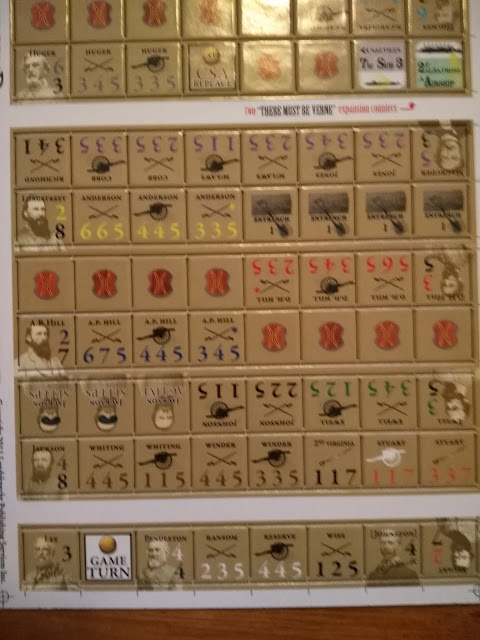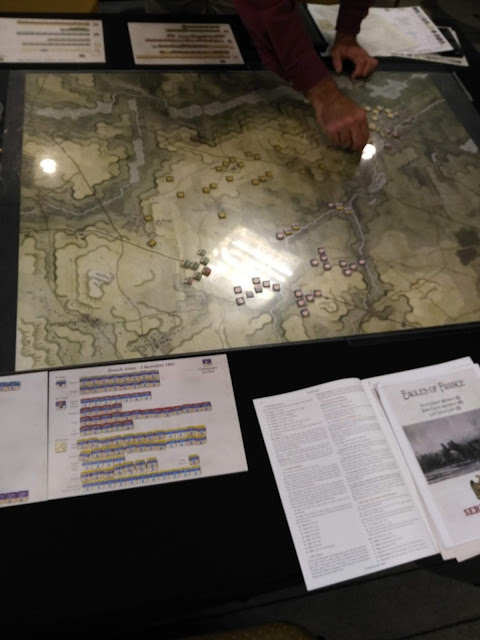Overview
Corsair Leader is the latest game from Dan Verssen Games which covers the airborne-antics of the Pacific Theatre. It is a solitaire game and for those familiar with the 'Leader' series follows the tried and trusted formula that the earlier games, e.g. Hornet Leader, Apache Leader etc. built upon. The game was a successful Kickstarter campaign raising many times over its funding goal.
The game pits you as a Squadron Commander that has to manage resources, i.e. pilots and aircraft to successful meet sortie objectives i.e. destroying targets, over a campaign series of linked missions. Each target, be it a fuel depot or enemy bombers grants a number of Victory Points which are tallied and compared against a Campaign VP achievement table to determine how successful you were.
There are 15 campaigns in the box, which is a testament to a successful Kickstarter, as many of them were stretch goals. After choosing a campaign and then your starting pilots, you'll 'fly' a number of missions which all follow the same 5 phases of play. The enemy, always the Japanese, will spawn randomly by a cup-draw mechanic, so no two missions will ever be the same. Each mission plays in about 20 minutes, sometimes much less, depending on the number of site and bandits i.e. the enemy, that appear to defend the target.
If you're curious about everything you get in the box, watch my unboxing video below (~14 mins)
Gameplay
Each mission consists of a Pre-flight planning phase, the Target Bound Flight, Target Resolution, Home Bound Flight and Debriefing. During the first of these phases the target, your pilots and their armaments will be selected, you'll also place the 'sites' which are the enemy ground units. There were many little touches in this game that I appreciated the design of and this was the first; it makes sense to me that your Intelligence will be more aware of the relatively static ground defences prior to a mission.
During the Target Bound Flight, you'll place your aircraft in any the Pre-Approach areas on the mounted Tactical Display. You'll only know where the enemy aircraft, 'bandits', appear after this step, nicely simulating the unknown quantity of WWII PTO Air Combat namely, finding and being found by the enemy. Another design appreciation moment came with the Event Cards which randomise an element of the Approach, Target and Home-bound phases, these cards serve to add some distinct flavour to each mission.
With practice, you'll be through the first two phases in less than 5 minutes. The meat of the tactical game comes during the Target Resolution phase, which is repeated 5 times, during which you'll attempt to engage bandits, destroy sites and the target without taking too much damage yourself.
Engaging bandits was a mini-game in its own right, and in fact felt like a very distilled version of the dogfighting manoeuvring of Wild Blue Yonder, in fact, the two games share a lot of common dog-fighting terminology. In a dogfight, you'll attempt to manoeuvre into favourable positions to attack, and with any bandit or site, 1 hit will be enough to destroy it. However, bandits are also manoeuvring to get into favourable positions against your aircraft determined by just two simple and quick-to-use tables on the mounted Dogfight Sheet.
Attacks, whether they're the enemies, your own, or whether the target is airborne or ground-based are resolved exactly the same way, by rolling 1d10. Each counter has got Attack Number(s) clearly printed on the top which the die result is compared to. If you've rolled greater than or equal to the first Attack Number, that's 1 hit on your target. If you've rolled greater than or equal to the second number that's two hits and so on. This is easily remembered and plays quickly, I thought it was an elegant way to determine combat results.
Attack rolls and Manoeuvre rolls may be modified by your pilots' and the enemies Air-to-Air or Air-to-Ground abilities or their relative position to each other confers dice modifiers as well. Some pilots will also fly with a Gung Ho counter which can be used prior to a dice roll to consider it a natural 10 (always a good thing in this game - unless rolling for the enemy!)
Your aircraft won't be in a position to actually attack the Missions' target until the 3rd round at the earliest and you'll only have 3 attempts to destroy the target, which will require multiple hits (6 was fairly common) to consider it destroyed. Each target also has a different number of bandits and sites that must be drawn to defend it along with a maximum number of aircraft that are allowed to go on the mission. It wouldn't be much of a game if you could send every aircraft at your disposal on every mission, each target felt well balanced if not thematic. I managed to fly a mission in the 1945 Luzon campaign without meeting a single bandit - probably quite accurate... Destroying a target nearly always feels like an achievement, especially in earlier Campaign missions in which the bandit and site counter mix are more aggressive.
The Home Bound Flight is where you'll attempt to rescue any of your 'downed' pilots and the Debrief is where you'll work out if any pilots have been promoted and how much stress they've accumulated, which should factor into your choice of pilot for the next mission. This strategic side of the game is also quite simple but more importantly, it's good fun. I enjoyed setting up my squadron and choosing the pilots, the experience they earnt over campaign almost gave me the same feeling of levelling up an RPG character which is unusual for a wargame.
Components
My previous experience with a 'Leader Series' game was with a Print-n-Play of Hornet Leader. My first and current impressions of this game are that the components are of a fantastic quality which put my homemade components (which I am quite proud of) to shame. The counters punched out more cleanly than any other game I've experienced and there were no chit-pulls to speak of anywhere.
Criticisms
My biggest gripe with this game is with the rules. They're well written, easy to understand and nicely laid out but I didn't find them to be fully comprehensive. There were a few edge cases during early plays of the game, specifically around dogfights, that were not covered. Only after repeated plays, did I satisfy myself that I was playing it correctly, and that was achieved by following the Sequence of Play absolutely literally.
The rules omit to mention anything about the Carrier and Island Operations charts that are included. I have assumed that these are optional parts of the game and I haven't tried them as there were very limited instructions on how to use them and references on them to counters that were not provided. I really like the thought behind them as there would be wildly different considerations for a Squadron Commander launching and recovering aircraft from an airfield or a carrier, but they feel a bit half-baked.
I found a few errors on cards that I have received which for the most part are of an excellent design and quality. Each pilot should have 3 double-sided cards to show their progression from Newbie, through Green, Average, Skilled, Veteran and to Legendary. however I have one pilot who can never be 'Skilled', his reverse side is for a different pilot, which is definitely a printing error. I checked and there are some more errata listed on the publishers game page and bgg discussions for it as well. However, it's good to see a publisher supporting their products; almost a necessity for wargame publishers.
After punching out the counters, I think I've organised and reorganised their storage 4 times. It should be a one-time-job but I was pretty jaded by the third time through. It would be nice if wargame publishers would add a section to their rules on efficient counter storage. Initially, I organised by aircraft types, then realised that a more sensible approach would also be organised by year, and then I realised I needed to factor in the Service (e.g. USAAF, USMC etc.) as well. To be told up front would be a boon, but at least I've now got lots of baggies which fit the box perfectly. This is a nice full box.
Conclusion
The Pacific Theatre is of particular interest to me and I'm grateful to own this solitaire take on tactical air combat in it. It plays quickly and has very high production values. The overall mechanism is quite simple but gives a nice feeling of accomplishment after a successful campaign.
Older games like B-17 feel like a purely random sequence of events to me with such little narrative I just never felt immersed. In this game, you're not just along for the ride. The Gung Ho counters and Special Options that you can spend, along with the levelling of your pilots as they progress through a campaign really add to the flavour and give you some tactical and strategic decisions which can make and break your missions.
The game system overall, and which is shared with all the other 'Leader' games is little lacking in narrative. However, the elements mentioned in the previous paragraph alongside the Event Cards and my imagination provided enough of a story to enjoy my time flying a Corsair over the Pacific against the Japanese Navy and Air Force. I certainly have enjoyed my time with this game and would like to thank Asmodee Distributors and Dan Verssen Games for sending this review copy.
If you didn't get in on the Kickstarter earlier this year, and if you did, why are you reading this?, it is still available and may even grace your Friendly Local Game Store's shelves. Find your nearest at http://www.findyourgamestore.co.uk/.
Publisher: Dan Verssen Games
Game Website: https://www.mcssl.com/store/danverssengames/corsair-leader
Players: 1
Designer: Dan Verssen
Playing time: 90 minutes +
RRP: £86.99






































Follow Us